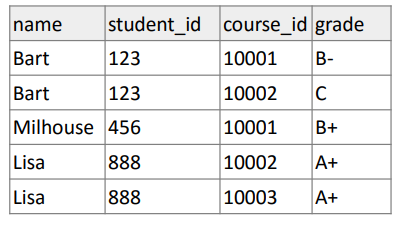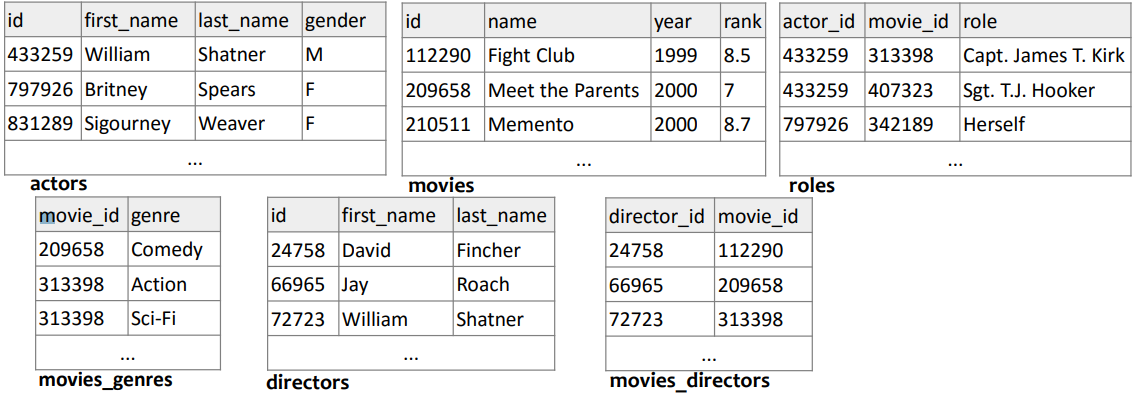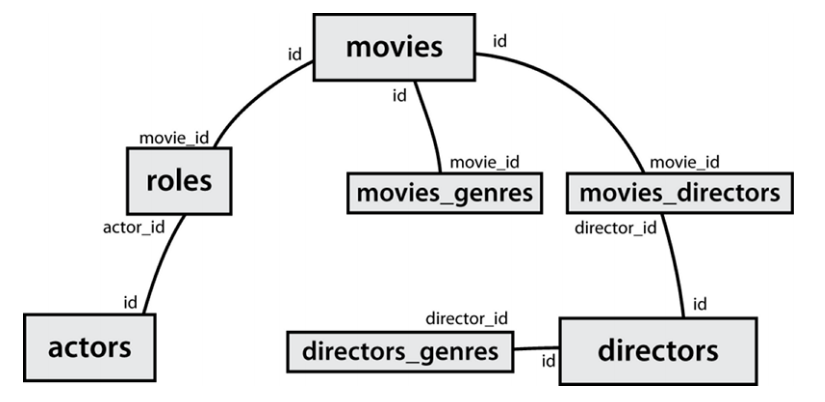Lecture 20 - SQL: Multi-Table Queries (JOINS)
Starting with a Quick Followup on PHP/PDO
Inserting through PHP
$count = $db->exec("INSERT INTO CUSTOMERS (ID,NAME,AGE,ADDRESS,SALARY)
VALUES (1, 'Ramesh', 32, 'Ahmedabad', 2000.00);");
PHP
exec runs the given SQL code and returns the number of rows affected.
Exceptions for PDO Errors
$db = new PDO("mysql:dbname=imdb_small", "jessica", "guiness");
$db->setAttribute(PDO::ATTR_ERRMODE, PDO::ERRMODE_EXCEPTION);
$rows = $db->query("SEEELECT * FROM movies WHERE year = 2000");
# kaboom!
PHP
Using setAttribute, you can tell PDO to throw (generate) a
PDOException when an error occurs.
The exceptions will appear as error messages on the page output.
You can catch the exception to gracefully handle the error.
SQL So Far
Database querying
Database manipulation (create/insert)
Accessing SQL from PHP with the PDO object
Multi-Table Queries (JOINS)

Related Tables and Keys

- Primary Key: a column guaranteed to be unique for each record (e.g. Lisa Simpson's ID 888)
- Foreign Key: a column in Table A storing a primary
key from table B
- (e.g. records with
gradeswithstudent_id)
- (e.g. records with
- Normalizing: Splitting tables to improve structure/redundancy (linked by unique IDs)
JOIN Template
SELECT col(s)
FROM table1, table2, ...
WHERE table1.a = table2.b
AND table2.c > '42';
SQL (template)
SELECT students.name, grades.*
FROM students, grades
WHERE students.id = grades.student_id
AND grades.grade > 'C';
SQL (example)

Result table
Giving Names to Tables
SELECT students.name, grades.*
FROM students, grades
WHERE students.id = grades.student_id
AND grades.grade > 'C';
SQL (example from previous slide)
A more compact solution (giving variable names to tables)
SELECT s.name, g.*
FROM students s, grades g
WHERE s.id = g.student_id
AND g.grade > 'C';
SQL (alternative example)
- You can give names to tables, like a variable in Java.
- To specify all columns in a table, write table.*
Note: An Equivalent Way to JOIN Tables
SELECT s.name, g.*
FROM students s, grades g
WHERE s.id = g.student_id
AND g.grade > 'C';
SQL (example from previous slide)
SELECT s.name, g.*
FROM students s
JOIN grades g ON s.id = g.student_id
WHERE g.grade > 'C';
SQL (alternative example, using the JOIN keyword)
The JOIN keyword is another way to join multiple tables. Some people find
this more intuitive, while others find joining tables on multiple WHERE conditions more
intuitive. Use whichever form you prefer most!
Note: There are other types of JOINS you may find on the recommended SQL query practice sites. You may learn these for fun if you'd like, but we don't cover it in this class (you will learn about them in other database courses). The JOIN keyword in this slide's example is also known as an "INNER JOIN"
A Suboptimal Query
Exercise: What courses have been taken by both Bart and Lisa?
SELECT bart.course_id
FROM grades bart, grades lisa
WHERE lisa.course_id = bart.course_id
AND bart.student_id = 123
AND lisa.student_id = 888;
SQL
What's wrong here?
- problem: requires us to know Bart/Lisa's student ID's, and only spits out course ids, not names
- Write a version of this query that gets us the course names and only requires to know Bart/Lisa's names, not their ID's.
Improved Query
What courses have been taken by both Bart and Lisa?
SELECT DISTINCT c.name
FROM courses c, students lisa, students bart, grades g1, grades g2
WHERE g1.course_id = c.id
AND g1.student_id = bart.id
AND g2.course_id = c.id
AND g2.student_id = lisa.id
AND bart.name = 'Bart'
AND lisa.name = 'Lisa';
Why so many tables?
- These are all of the tables we will need to get the correct result. We want to treat
Lisa and Bart's
studentandgradesinformation distinctly, so we need to have two variables for each of these tables to join them correctly.
Practice Queries
What are the names of all teachers Bart has had?
SQL
How many total students has Ms. Krabappel taught, and what are their names?
SQL
Designing a Query (Refer to this slide often!)
Figure out the proper SQL queries in the following way:
- Which table(s) contain the critical data? (
FROM) - Which columns to I need in the result set? (
SELECT) - How are tables connected (
JOINand/orWHERE) and values filtered (WHERE)? - Do I need to return only
DISTINCTrecords? - Do I care about the order of records returned? If so, which columns do I need to sort by and in what precedence?
Example Database (also on query tester)

imdb-smallis also provided on the query tester page for testing queries with a smaller dataset
IMDB Table Relationships/ids

IMDB Practice Queries
What are the names of all movies released in 1995?
How many people played a part in the movie "Lost in Translation"?
What are the names of all the people who played a part in the movie "Lost in Translation"?
Who directed the movie "Fight Club"?
How many movies has Clint Eastwood directed?
What are the names of all movies Clint Eastwood has directed?
What are the names of all directors who have directed at least one horror film?
What are the names of every actor who has appeared in a movie directed by Christopher Nolan?
Practice at Home
Tips for practicing SQl for your final HW and the exam:
-
Write a simple
create.sqlfile, creating a few tables of your choice. -
Use
INSERTstatements to populate these tables with different data (as Kyle did for his todolist example on Friday -
In Cloud9, start
mysqland usesource create.sqlto create your tables in your mysql database. - Write a PHP file that sets up a PDO object, and then executes a few more INSERT statements on your tables to add a few more records
- Write a simple SELECT query in your PHP file
- Now use JOIN to join your tables based on criteria you come up with (e.g. make your own query questions!)
This exercise is actually not too long, but will be very helpful for HW7 and your creative projects (and could be a good piece in your software development portfolio